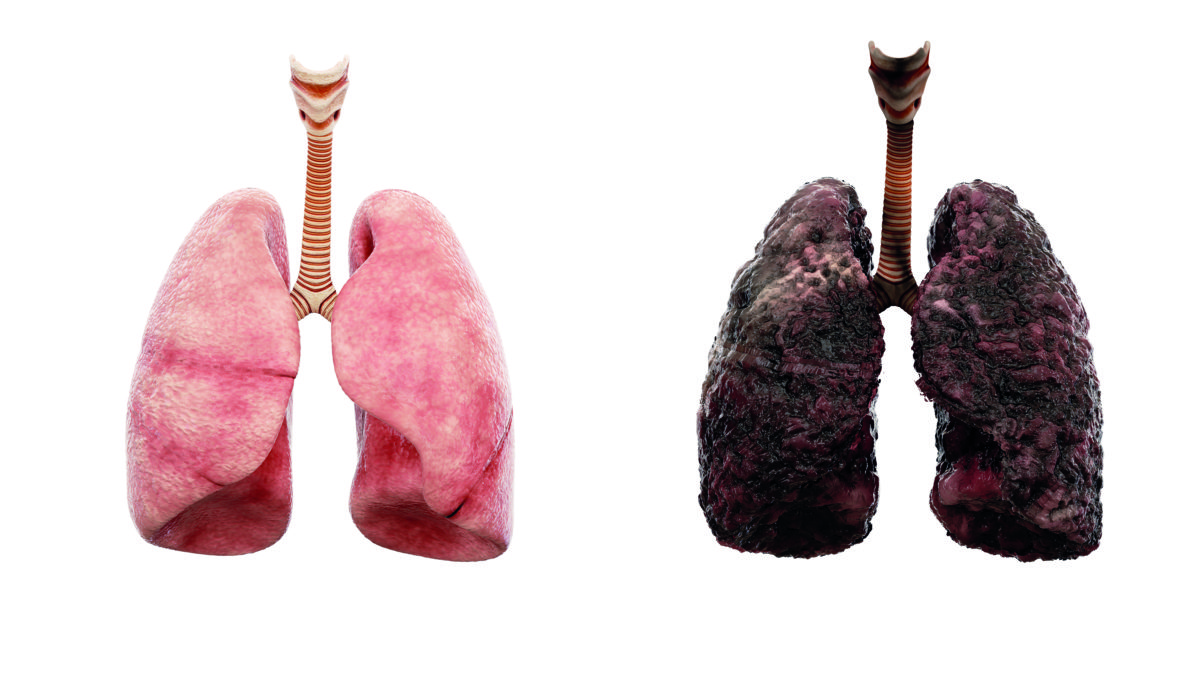Despite the rising incidence of a rare lung infection that is challenging to both diagnose and treat, leading respiratory physicians have said that there is light at the end of the tunnel. Ian Mason explains.
Mycobacteria – a family of small, rod-shaped bacilli – have proved a scourge throughout human history. They are responsible for some truly terrible diseases including tuberculosis (mycobacterium tuberculosis) and leprosy (mycobacterium leprae).
Other members of this troublesome family are responsible for a growing number of serious lung infections. (1) The culprits are called nontuberculous mycobacteria (NTM) – and if you took a shower or bath this morning, you may have inhaled scores of these potential pathogens. (2)
They thrive in drinking water, household plumbing, peat rich soils, brackish marshes and drainage water. Even hospital water systems, haemodialysis centres and dental surgeries have been found to harbour high rates of NTM colonisation. (3)
In susceptible individuals, NTM can cause progressive inflammatory lung damage, a condition termed ‘NTM-lung disease’ (NTM-LD), sometimes also referred to as NTM-pulmonary disease (NTM-PD). However, just to confuse the picture, these bacteria can also be occasional or permanent lung residents without causing NTM-LD. (4)
Those most at risk of developing overt NTM-LD include immunosuppressed individuals or those with pre-existing lung damage from chronic diseases such as asthma, COPD, bronchiectasis, pneumoconiosis or aspergillosis (4) – however NTM-LD may occur in people with no overt immune deficiency. (5)
Studies from many countries point to an increasing prevalence of NTM-LD over time, leading some authors to conclude that ‘NTM are emerging worldwide as significant causes of chronic pulmonary infection, posing a number of challenges for both clinicians and researchers.’ (6)
What’s Happening in the UK?
In England, Wales and Northern Ireland, the reported rate of NTM isolation (from humans) more than doubled between 1996-and-2006. A more recent study found that incidence of NTM isolation rose from 5.6-to-7.6 per 100,000 between 2007-and-2012. The organisms most frequently cultured from pulmonary isolates were members of the mycobacterium avium-intracellulare complex family (MAC), and the incidence of pulmonary MAC increased significantly from 1.3-to-2.2 per 100,000 between 2007-and-2012. The majority of these individuals were over 60 years old. The authors concluded that, ‘The incidence of NTM has continued to rise since the last national analysis. Overall, this represents an almost 10-fold increase since 1995. Pulmonary MAC in older individuals is responsible for the majority of this change.’(5)
These findings are reflected at the sharp end of clinical practice. Professor James Chalmers, Consultant Respiratory Physician at the University of Dundee School of Medicine, says that he is seeing more patients with NTM-LD, commenting, ‘Rates are clearly going up, predominantly in the elderly and in people with existing respiratory illness. When I first started in my clinic, we saw very few patients with NTM-LD, but now we find this in around one-in-10 of our bronchiectasis patients.
‘We face enormous challenges when treating these patients. For those who do not manage this disease every day, there is a lack of dependable specialist advice. Patients may have multiple comorbidities, their clinical course is difficult to predict, the drugs we currently use to treat NTM-LD can be toxic, and we have real difficulties managing those toxicities.’
High Risk of Mortality
A recent research publication (7) by Dr Marc Lipman, Division of Medicine, University College London and Royal Free Hospital NHS Foundation Trust, notes the rising incidence of NTM-LD caused by MAC in apparently immune-competent people. Dr Lipman’s review also described the potential seriousness of these infections.
‘Most studies in patients with MAC pulmonary disease (NTM-PD) document a five-year all-cause mortality exceeding 25 per cent, indicating poor prognosis… these findings emphasise the need for more effective management,’ the review concluded.
The concern of Dr Lipman and his colleagues is reflected by a growing interest in NTM-LD at major respiratory meetings, such as the European Respiratory Society and the British Thoracic Society (BTS), with new disease registries and major research projects underway in many countries.
In the UK, the BTS published new guidelines on the management of NTM-LD (4) in 2017, the first update since 2000. These echo the need for more effective and more tolerable NTM treatment regimens, stating, ‘Why is this important? We currently use combination antibiotic regimens that are often associated with significant toxicity, require prolonged administration, and particularly in the case of mycobacterium abscessus frequently fail. There remain considerable challenges in co-ordinating and funding multicentre studies of novel drugs or new combinations of existing drugs for NTM infections.’
Given this, it’s perhaps unsurprising that adherence with treatment guidelines is poor. (8) Speaking at a BTS winter meeting (London 5th-to-7th December 2018), Dr Jennifer Quint, Reader in Respiratory Epidemiology, National Heart and Lung Institute, Imperial College, London, said that only around half of NTM disease patients who are managed in primary care are treated according to guidelines. (9)
The complexity and potential toxicity of current treatment regimens has spurred interesting research in which a pharmacist took increased responsibility for the management of NTM-LD. Pharmacy staff were trained to identify, resolve, and prevent drug-related adverse events. A pilot study found a high level of patient-satisfaction when a pharmacist took a leading role in the multidisciplinary care team and furthermore that specialist non-physician healthcare workers can act as both a patient’s support and advocate. (10)
If in Doubt… Refer
The published BTS guidelines also underscore the importance of the time-honoured clinical maxim – if in doubt refer to a specialist centre. The guidelines are clear that ‘individuals with NTM-PD should be managed in collaboration with a physician experienced in managing NTM-PD.’
Professor Chalmers agrees, saying, ‘I see patients whose diagnosis of NTM-LD has been delayed. For example, they are treated for bronchiectasis but nobody thinks about NTM. Clear clinical pointers such as a non-productive cough are ignored. The patient has been given multiple therapies without anyone stopping to say ‘this is not behaving like asthma or bronchiectasis’ or classic features of NTM-LD are not reported by the radiologist. Out there in the majority of respiratory clinics NTM is not top of the agenda and it is part of our job to make this top of the agenda, because this is a much bigger problem than previously recognised.’
In order to address some of these shortcomings, Professor Chalmers and Dr Marc Lipman have co-founded NTM Patient Care UK, a new charity (and the first in the UK), specifically devoted to the empowerment, education, and advocacy of people with NTM disease and their carers.
‘What else can we do in the next five years that will make a difference? We need more burden of disease data for NTM-LD, better diagnostics and better treatments. We need to educate GPs and hospital physicians who do not have this on their radar, that this is something they should think about so that patients with COPD, bronchiectasis or other underlying lung disease get referred to an NTM specialist,’ said Professor Chalmers.
Key Facts About NTM
• More than 150 different species of NTM have been described, however pulmonary infections are most commonly due to mycobacterium avium complex, mycobacterium kansasii, and mycobacterium abscessus (3)
• Although NTM infection has traditionally been associated with immunosuppressed individuals or those with severe underlying lung damage, NTM-LD may occur in people with no overt immune deficiency (5)
• NTM-LD requires a multidisciplinary approach and may require input from hospital specialists in respiratory medicine, pharmacy, infectious diseases, paediatrics, microbiology, immunology and radiology (10, 11)
• NTM are aerobic, non-motile and ubiquitous in the environment with the heaviest concentrations found in soil and water sources. An unusually thick cell wall and a preference to live in biofilms make it difficult for disinfectants or antibiotics to kill them. They are easily aerosolized with associated risk of inhalation and infection (3)
• The treatment of NTM-LD involves complex drug regimens that are commonly associated with intolerance and toxicity (4)
References
1. Satta G, McHugh TD, Mountford J, et al. Managing pulmonary nontuberculous mycobacterial infection. Time for a patient-centered approach. Ann Am Thorac Soc. 2014 Jan;11(1):117-21
2. Thomson R, Tolson C, Carter R et al. Isolation of nontuberculous mycobacteria (NTM) from household water and shower aerosols in patients with pulmonary disease caused by NTM. J. Clin. Microbiol. 2013 Sep 1;51(9):3006-11
3. Johnson MM, Odell JA. Nontuberculous mycobacterial pulmonary infections. J Thorac Dis. 2014 Mar;6(3):210
4. Haworth CS, Banks J, Capstick T, et al. British Thoracic Society guidelines for the management of non-tuberculous mycobacterial pulmonary disease (NTM-PD). Thorax. 2017 Nov 1;72(Suppl 2):ii1-64
5. Shah NM, Davidson JA, Anderson LF, et al. Pulmonary Mycobacterium avium-intracellulare is the main driver of the rise in non-tuberculous mycobacteria incidence in England, Wales and Northern Ireland, 2007–2012. BMC Infect Dis. 2016 Dec;16(1):195
6. Stout JE, Koh WJ, Yew WW. Update on pulmonary disease due to non-tuberculous mycobacteria. Int J Infect Dis. 2016 Apr 1;45:123-34
7. Diel R, Lipman M, Hoefsloot W. High mortality in patients with Mycobacterium avium complex lung disease: a systematic review. BMC Infect Dis. 2018 Dec;18(1):206
8. Adjemian J, Prevots DR, Gallagher J, et al. Lack of adherence to evidence-based treatment guidelines for nontuberculous mycobacterial lung disease. Ann Am Thorac Soc. 2014 Jan;11(1):9-16
9. Axson EL, Bloom CI, Quint JK. Nontuberculous mycobacterial disease managed within UK primary care, 2006–2016. Eur J Clin Microbiol Infect Dis. 2018 Sep 1;37(9):1795-803
10. Wix K, Odell L, Fisher S, et al. Pharmacist-physician collaboration in management of nontuberculous mycobacterial pulmonary disease. Am J Respir Crit Care Med. 2010;181:A2595
11. Haworth CS, Banks J, Capstick T, et al. British Thoracic Society Guideline for the management of non-tuberculous mycobacterial pulmonary disease (NTM-PD) (Summary document). BMJ Open Resp Res. 2017 Oct 1;4(1):e000242








